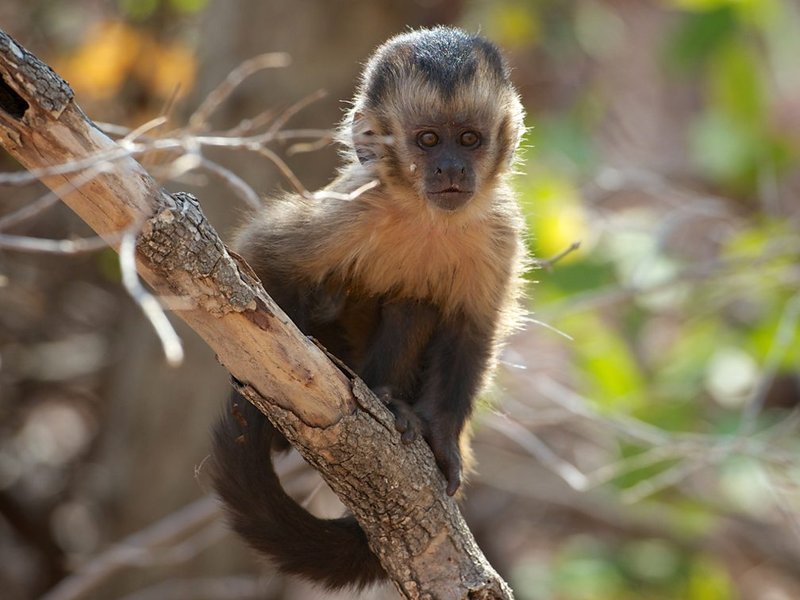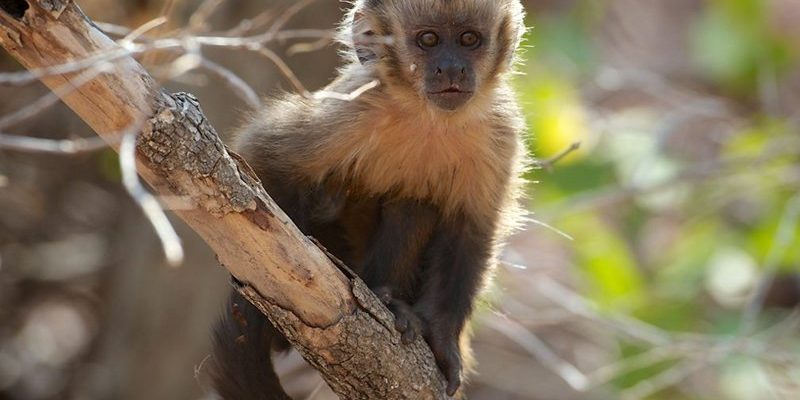
When you think of monkeys, the Tufted Capuchin might not be the first one that springs to mind. But these charming little creatures deserve a closer look! Known for their round faces, expressive eyes, and tuft of hair that gives them a unique appearance, Tufted Capuchins are not only adorable but also incredibly intelligent. They belong to the Capuchin family, which is famous for its problem-solving abilities and social behaviors.
Imagine sipping coffee in a tranquil rainforest, with the sounds of nature surrounding you. Suddenly, a group of Tufted Capuchins swings by, chattering and playing, reminding you of childhood games. They bring life to their habitats, living in small groups that showcase their complex social structures. Curious about what makes these primates tick? Let’s dive deeper into their world.
Physical Characteristics
The Tufted Capuchin is a medium-sized monkey, typically measuring about 16 to 24 inches in body length, excluding the tail, which can add another 16 to 20 inches! They usually weigh between 4 to 10 pounds. Their small stature, combined with their agile limbs, allows them to navigate trees with ease, making them skilled climbers.
One of the most striking features of the Tufted Capuchin is its name. They possess a tuft of hair on top of their heads, which gives them a distinctive look. Their fur ranges from light brown to black, often with a lighter face and neck area. The contrast between their dark fur and their expressive, bright eyes creates an endearing appearance that many find hard to resist.
These monkeys are also known for their incredibly flexible tails, which they use almost like an extra hand. This prehensile tail allows them to grip branches while they forage for food or play, making them even more adept at living in the treetops of their tropical habitats.
Habitat and Range
Tufted Capuchins are primarily found in the lush rainforests of Central and South America. Their range includes countries like Brazil, Colombia, Ecuador, and parts of Panama. They thrive in these humid environments, where tall trees offer both food and shelter. The canopy of the forest is their playground, where they leap from branch to branch with remarkable agility.
These monkeys prefer habitats that are dense in foliage because it provides them with protection from predators and a rich supply of food. They often stay in areas with a mix of tall trees and underbrush, which helps them find fruit, seeds, and insects. This adaptability to different forest types showcases their resourcefulness and ability to survive in ever-changing environments.
With deforestation being a significant threat, Tufted Capuchins face challenges in their natural habitats. As more trees are cut down, they find it harder to locate food and safe nesting spots. Protecting their habitats is crucial for the survival of these playful primates.
Diet and Foraging Behavior
When it comes to food, the Tufted Capuchin is an omnivores, meaning they enjoy a diverse diet. They mainly feed on fruits, nuts, seeds, and small insects. In fact, they have a particular love for ripe fruits, making them important seed dispersers in their ecosystems. When they eat fruit, they contribute to the health and growth of the forest around them.
These monkeys are clever foragers. They often use tools to help them reach food that would otherwise be out of their grasp. For instance, they might use sticks to pry insects out of tree bark or crack open hard nuts. This tool use is a sign of their intelligence and creativity, highlighting their problem-solving skills.
Interestingly, Tufted Capuchins will also share food within their groups. This social behavior reinforces bonds between individuals and ensures that everyone in the troop gets a chance to eat. You can think of it as a natural team effort, reflecting their tight-knit communities.
Social Structure and Behavior
Tufted Capuchins live in social groups that usually consist of between 15 to 20 individuals. These groups are often family-oriented, with strong bonds between parents and their offspring. The social dynamics are fascinating; they have complex hierarchies with dominant and subordinate members. You might find that they exhibit playful behavior, grooming, and vocal communication to maintain harmony within the troop.
When they’re not busy foraging or grooming each other, Tufted Capuchins enjoy playful antics that can resemble children at play. You may see them swinging from branches, chasing each other, or engaging in mock fights, which helps them develop their skills and socialize. Play is essential for their development, ensuring they learn how to interact with others in their community.
Interestingly, Tufted Capuchins communicate using various vocalizations, body gestures, and facial expressions. This rich form of communication allows them to convey different messages, whether signaling danger or simply calling out to one another. Their ability to convey emotions through such methods adds another layer to their complex social interactions.
Reproduction and Lifespan
The breeding season for Tufted Capuchins typically takes place throughout the year, although it can vary depending on environmental factors. After a gestation period of about 150 to 180 days, females usually give birth to a single baby. Twins are rare but can occur. The newborns are incredibly fragile and rely heavily on their mothers for care, warmth, and nutrition.
Mother Tufted Capuchins are very attentive, holding their babies close and teaching them important skills as they grow. Young monkeys often stay with their mothers for several years, learning about social behavior, foraging techniques, and group dynamics during this time. This extended care is essential for their survival, helping them become well-adjusted members of their community.
In the wild, Tufted Capuchins can live up to 25 years, while those in captivity may live even longer, sometimes reaching 30 years or more. Factors like diet, habitat, and social interactions can influence their lifespan, making it crucial for them to thrive in safe, healthy environments.
Conservation Status
Currently, the Tufted Capuchin is listed as a species of “Least Concern” by the International Union for Conservation of Nature (IUCN). However, habitat destruction and hunting pose significant risks to their populations in the wild. As their forest homes shrink due to logging and agriculture, Tufted Capuchins face challenges in finding food and safe living spaces.
Conservation efforts are vital to ensure the survival of these fascinating primates. Programs aimed at preserving their habitats, protecting them from poaching, and raising awareness about the importance of biodiversity can make a difference. Organizations working to restore forest areas and create protected reserves are essential in maintaining the balance of ecosystems where Tufted Capuchins reside.
Moreover, education plays a key role in conservation. By informing local communities about the significance of Tufted Capuchins and the biodiversity they contribute to, we can foster a greater appreciation for these wonderful primates and their habitats.
Interesting Facts
| Common Name: | Tufted Capuchin |
| Scientific Name: | Cebus apella |
| Size: | 16–24 inches (body) 16–20 inches (tail) |
| Weight: | 4–10 pounds |
| Diet: | Fruits, seeds, insects, small animals |
| Lifespan: | Up to 25 years in the wild 30 years in captivity |
| Habitat: | Tropical rainforests of Central and South America |
FAQ
What makes Tufted Capuchins unique compared to other monkeys?
Tufted Capuchins stand out due to their distinctive tuft of hair on their heads and their remarkable intelligence. They are one of the few primate species known to use tools, which is a testament to their cognitive abilities. Unlike some other monkeys, Tufted Capuchins also exhibit complex social behaviors and strong family bonds, making them fascinating creatures to study.
Are Tufted Capuchins friendly towards humans?
While Tufted Capuchins can be curious and playful around humans, they are wild animals and should be respected as such. In some cases, they can form bonds with humans, especially if raised in captivity. However, interacting with wild Tufted Capuchins can be unpredictable, and it’s important to appreciate them from a distance to avoid stressing them or disrupting their natural behaviors.
How can I help protect Tufted Capuchins?
Supporting conservation initiatives that focus on preserving their habitats is one significant way to help Tufted Capuchins. Donating to wildlife organizations, participating in awareness programs, and promoting sustainable practices can all make a difference. Additionally, educating others about the importance of biodiversity and the need to protect these primates is crucial for their future.
Do Tufted Capuchins have any natural predators?
Yes, Tufted Capuchins face threats from various predators in their natural habitat. Birds of prey, snakes, and big cats like jaguars can all pose risks to these small monkeys. Their social structure and agility in trees usually help them evade danger, but they still need to remain vigilant in their environment.
What types of sounds do Tufted Capuchins make?
Tufted Capuchins communicate using a range of vocalizations, including whistles, barks, and grunts. Each sound can convey different messages, from alerting others about danger to signaling a call for food. These vocalizations play a crucial role in maintaining the social structure and group dynamics within their communities.
Can Tufted Capuchins be kept as pets?
Though they are charming creatures, Tufted Capuchins are not suitable pets. They require specific care, complex social interactions, and a large amount of space to thrive. Keeping them in captivity often leads to behavioral issues and health problems. It’s crucial to appreciate them in the wild or through reputable sanctuaries that focus on their well-being.
What do Tufted Capuchins use tools for?
Tufted Capuchins use tools primarily for foraging. They may use sticks to extract insects from tree crevices or stones to crack open hard nuts. This ability to use tools demonstrates their intelligence and adaptability in seeking out food. It’s an impressive skill that sets them apart from many other primate species.
How do Tufted Capuchins cope with environmental changes?
Tufted Capuchins are generally resilient creatures, but they face challenges when their habitats undergo significant changes. They often adapt by altering their foraging patterns or exploring new areas for food. However, severe habitat destruction can lead to stress and decline in their populations. It’s essential to protect their natural environments to ensure their survival.
What do baby Tufted Capuchins look like?
Baby Tufted Capuchins are incredibly adorable with their tiny frames and soft fur. They are typically born with lighter fur that gradually darkens as they grow. Their big eyes and playful nature make them endearing. Babies cling to their mothers for warmth and protection, learning essential survival skills during their early years.
Are Tufted Capuchins social animals?
Yes, Tufted Capuchins are highly social animals. They live in groups, often consisting of family units, and engage in various social behaviors such as grooming and playing. Their social structure is vital for their survival, allowing them to work together for food and safety. These interactions also strengthen their bonds and enhance their community dynamics.

